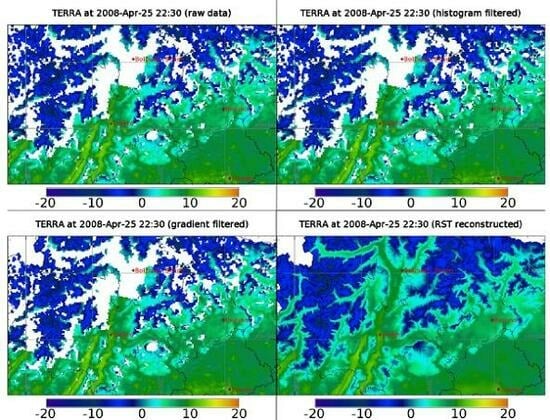Estimating Daily Land Surface Temperatures in Mountainous Environments by Reconstructed MODIS LST Data
Abstract
:1. Introduction
- present a novel approach to reconstructing MODIS LST data, including rejection of poor quality pixels by application of MODIS quality maps, low-range temperature outlier elimination based on histogram data, and temperature gradient-based map reconstruction with volumetric spline interpolation to fill all void map areas paying special attention to complex terrain;
- compare the reconstructed LST map time series to instantaneous and aggregated meteorological temperature measurements in order to assess the quality of the reconstruction;
- derive climatic parameters from reconstructed LST time series as maps, to be used as input variables for ecological and epidemiological modeling.
2. Materials and Methods
2.1. Study Region
2.2. Available Data
2.3. MODIS LST Map Reconstruction Method
- Cross-checking of Land Surface Temperature against elevation (analysis of relationship);
- Comparison with meteorological measurements (instantaneous meteorological measurements; comparison of periodical, monthly and annual averages; comparison of short term trends);
- Comparison with LANDSAT-TM thermal maps.
2.4. Time Series Aggregation
3. Results and Discussion
3.1. MODIS QA Statistics
3.2. Reconstructed LST Maps
3.3. Quality of the Reconstructed Daily MODIS LST Maps
3.4. Derived Indicators: Exceptional Months and Seasons
3.5. Derived Indicators: Growing Degree Days
4. Conclusions
Acknowledgements
References and Notes
- Steinacker, R.; Ratheiser, M.; Bica, B.; Chimani, B.; Dorninger, M.; Gepp, W.; Lotteraner, C.; Schneider, S.; Tschannett, S. A mesoscale data analysis and downscaling method over complex terrain. Mon. Weather Rev. 2006, 134, 2758–2771. [Google Scholar] [CrossRef]
- Hassan, Q.; Bourque, C. Potential species distribution of balsam fir based on the integration of biophysical variables derived with remote sensing and process-based methods. Remote Sens. 2009, 1, 393–407. [Google Scholar] [CrossRef]
- Kerr, J.T.; Ostrovsky, M. From space to species: ecological applications for remote sensing. Trend. Ecol. Evolut. 2003, 18, 299–305. [Google Scholar] [CrossRef]
- Hais, M.; Kučera, T. The influence of topography on the forest surface temperature retrieved from Landsat TM, ETM+ and ASTER thermal channels. ISPRS J. Photogramm. Remote Sens. 2009, 64, 585–591. [Google Scholar] [CrossRef]
- Neteler, M. Time series processing of MODIS satellite data for landscape epidemiological applications. Int. J. Geoinf. 2005, 1, 133–138. [Google Scholar]
- Rizzoli, A.; Neteler, M.; Rosà, R.; Versini, W.; Cristofolini, A.; Bregoli, M.; Buckley, A.; Gould, E. Early detection of TBEv spatial distribution and activity in the Province of Trento assessed using serological and remotely-sensed climatic data. Geospatial Health 2007, 1, 169–176. [Google Scholar] [CrossRef]
- Tatem, A.J.; Goetz, S.J.; Hay, S.I. Terra and Aqua: new data for epidemiology and public health. Int. J. Appl. Earth Obs. Geoinf. 2004, 6, 33–46. [Google Scholar] [CrossRef]
- Justice, C.O.; Vermote, E.; Townshend, J.R.G.; Defries, R.; Roy, D.P.; Hall, D.K.; Salomonson, V.V.; Privette, J.L.; Riggs, G.; Strahler, A.; Lucht, W.; Myneni, R.B.; Knyazikhin, Y.; Running, S.W.; Nemani, R.R.; Wan, Z.; Huete, A.R.; van Leeuwen, W.; Wolfe, R.E.; Giglio, L.; Muller, J.; Lewis, P.; Barnsley, M.J. The Moderate Resolution Imaging Spectroradiometer (MODIS): land remote sensing for global change research. IEEE Trans. Geosci. Remote Sens. 1998, 36, 1228–1249. [Google Scholar] [CrossRef]
- Holben, B. Characteristics of maximum-value composite images from temporal AVHRR data. Int. J. Remote Sens. 1986, 7, 1417–1434. [Google Scholar] [CrossRef]
- Myneni, R.; Tucker, C.; Asrar, G.; Keeling, C. Interannual variations in satellite-sensed vegetation index data from 1981 to 1991. J. Geophys. Res. 1998, 103, 6145–6160. [Google Scholar] [CrossRef]
- Pettorelli, N.; Vik, J.O.; Mysterud, A.; Gaillard, J.; Tucker, C.J.; Stenseth, N.C. Using the satellite-derived NDVI to assess ecological responses to environmental change. Trend. Ecol. Evolut. 2005, 20, 503–510. [Google Scholar] [CrossRef]
- Beck, P.S.; Atzberger, C.; Hogda, K.A.; Johansen, B.; Skidmore, A.K. Improved monitoring of vegetation dynamics at very high latitudes: a new method using MODIS NDVI. Remote Sens. Environ. 2006, 100, 321–334. [Google Scholar] [CrossRef]
- Scharlemann, J.P.; Benz, D.; Hay, S.I.; Purse, B.V.; Tatem, A.J.; Wint, G.R.; Rogers, D.J. Global data for ecology and epidemiology: a novel algorithm for temporal fourier processing MODIS data. PLoS ONE 2008, 3, e1408. [Google Scholar] [CrossRef]
- Justice, C.O.; Townshend, J.R.G.; Vermote, E.F.; Masuoka, E.; Wolfe, R.E.; Saleous, N.; Roy, D.P.; Morisette, J.T. An overview of MODIS Land data processing and product status. Remote Sens. Environ. 2002, 83, 3–15. [Google Scholar] [CrossRef]
- Pasotti, L.; Maroli, M.; Giannetto, S.; Brianti, E. Agrometeorology and models for the parasite cycle forecast. Parassitologia 2006, 48, 81–83. [Google Scholar]
- Hassan, Q.K.; Bourque, C.P.; Meng, F.R.; Richards, W. Spatial mapping of growing degree days: an application of MODIS-based surface temperatures and Enhanced Vegetation Index. J. Appl. Remote Sens. 2007, 1, 013511. [Google Scholar] [CrossRef]
- Rogers, D.J.; Hay, S.I.; Packer, M.J. Predicting the distribution of tsetse flies in West Africa using temporal Fourier processed meteorological satellite data. Ann. Trop. Med. Parasitol. 1996, 90, 225–241. [Google Scholar] [CrossRef]
- Jönsson, P.; Eklundh, L. Seasonality extraction by function fitting to time-series of satellite sensor data. IEEE Trans. Geosci. Remote Sens. 2002, 40, 1824–1832. [Google Scholar] [CrossRef]
- Tran, H.; Uchihama, D.; Ochi, S.; Yasuoka, Y. Assessment with satellite data of the urban heat island effects in Asian mega cities. Int. J. Appl. Earth Obs. Geoinf. 2006, 8, 34–48. [Google Scholar] [CrossRef]
- Ackerman, S.; Strabala, K.; Menzel, P.; Frey, R.; Moeller, C.; Gumley, L. Discriminating clear sky from clouds with MODIS. J. Geophys. Res. 1998, 103, 141–157. [Google Scholar] [CrossRef]
- Colombi, A.; De Michele, C.; Pepe, M.; Rampini, A. Estimation of daily mean air temperature from MODIS LST in Alpine areas. EARSeL eProc. 2007, 6, 38–46. [Google Scholar]
- Wan, Z. MODIS Land-Surface Temperature Products Users' Guide. 2003. Available online: http://www.icess.ucsb.edu/modis/LstUsrGuide/usrguide.html (accessed on 8 January 2010).
- Wan, Z. New refinements and validation of the MODIS land-surface temperature/emissivity products. Remote Sens. Environ. 2008, 112, 59–74. [Google Scholar] [CrossRef]
- Wan, Z. MODIS Land-Surface Temperature. Algorithm Theoretical Basis Document (LST ATBD): LST Calculations. 1999. Available online: http://modis.gsfc.nasa.gov/data/atbd/atbd_mod11.pdf (accessed on 8 January 2010).
- Wan, Z.; Zhang, Y.; Zhang, Q.; Li, Z.L. Quality assessment and validation of the MODIS global land surface temperature. Int. J. Remote Sens. 2004, 25, 261–274. [Google Scholar] [CrossRef]
- Neteler, M.; Mitasova, H. Open Source GIS: A GRASS GIS Approach; Springer: New York, NY, USA, 2008. [Google Scholar]
- MODIS Reprojection Tool V4.0 Software. Available online: https://lpdaac.usgs.gov/lpdaac/tools/modis_reprojection_tool (accessed on 8 January 2010).
- Hutchinson, M.F. Interpolating mean rainfall using thin plate smoothing splines. Int. J. Geogr. Inf. Sci. 1995, 9, 385–403. [Google Scholar] [CrossRef]
- Hofierka, J.; Parajka, J.; Mitasova, H.; Mitas, L. Multivariate interpolation of precipitation using regularized spline with tension. Trans. GIS 2002, 6, 135–150. [Google Scholar] [CrossRef]
- New, M.; Hulme, M.; Jones, P. Representing twentieth-century space-time climate variability. Part I: Development of a 1961-90 mean monthly terrestrial climatology. J. Climate 1999, 12, 829–856. [Google Scholar] [CrossRef]
- Hay, S.I.; Tucker, C.J.; Rogers, D.J.; Packer, M.J. Remotely sensed surrogates of meteorological data for the study of the distribution and abundance of arthropod vectors of disease. Ann. Trop. Med. Parasitology 1996, 90, 1–19. [Google Scholar] [CrossRef]
- Hijmans, R.J.; Cameron, S.E.; Parra, J.L.; Jones, P.G.; Jarvis, A. Very high resolution interpolated climate surfaces for global land areas. Int. J. Climatol. 2005, 25, 1965–1978. [Google Scholar] [CrossRef]
- Randolph, S.E.; Green, R.M.; Peacey, M.F.; Rogers, D.J. Seasonal synchrony: the key to tick-borne encephalitis foci identified by satellite data. Parasitology 2000, 121, 15–23. [Google Scholar] [CrossRef]
- Carpi, G.; Cagnacci, F.; Neteler, M.; Rizzoli, A. Tick infestation on roe deer in relation to geographic and remotely sensed climatic variables in a tick-borne encephalitis endemic area. Epidemiol. Infect. 2008, 1416–1424. [Google Scholar] [CrossRef]
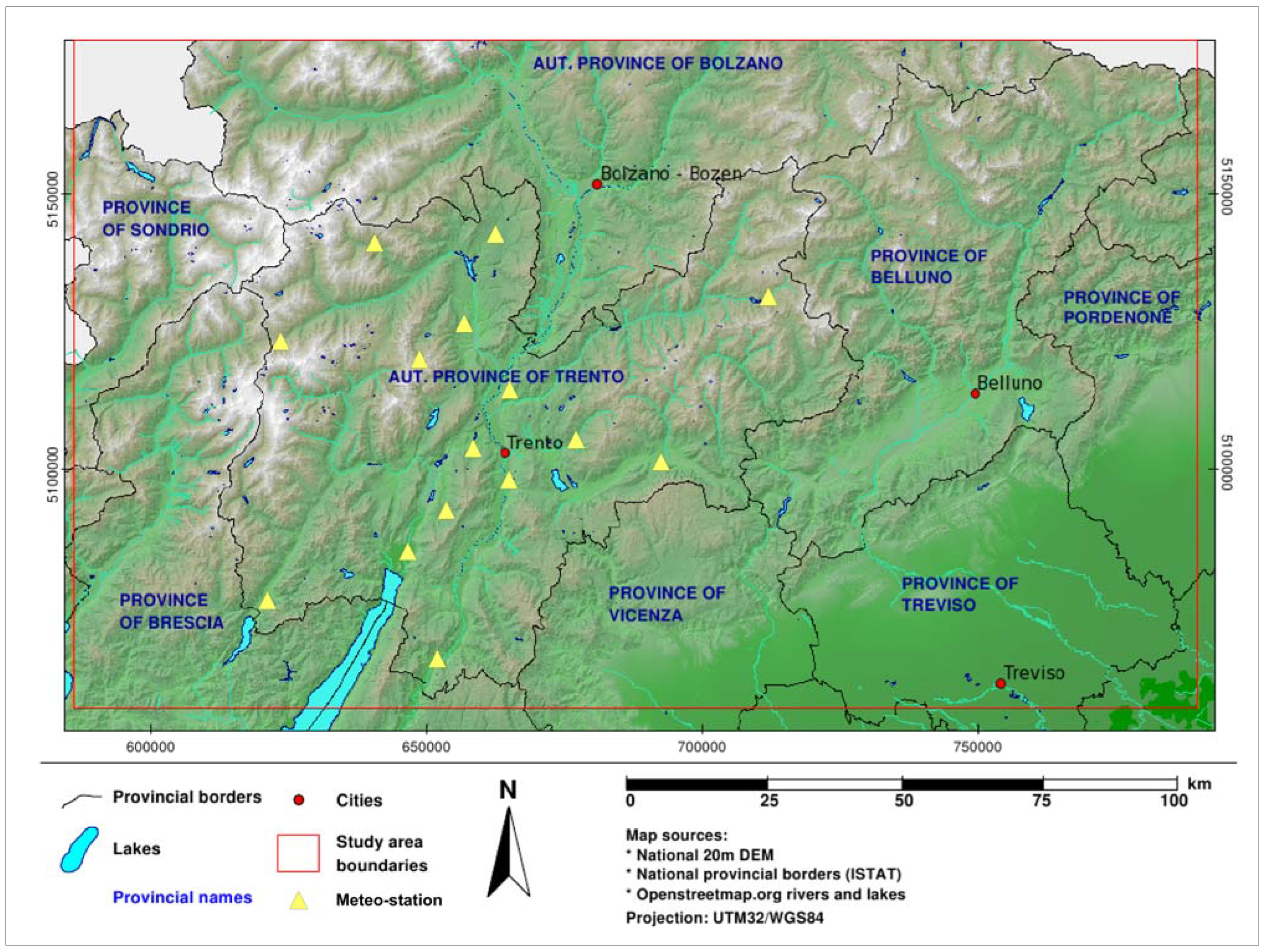
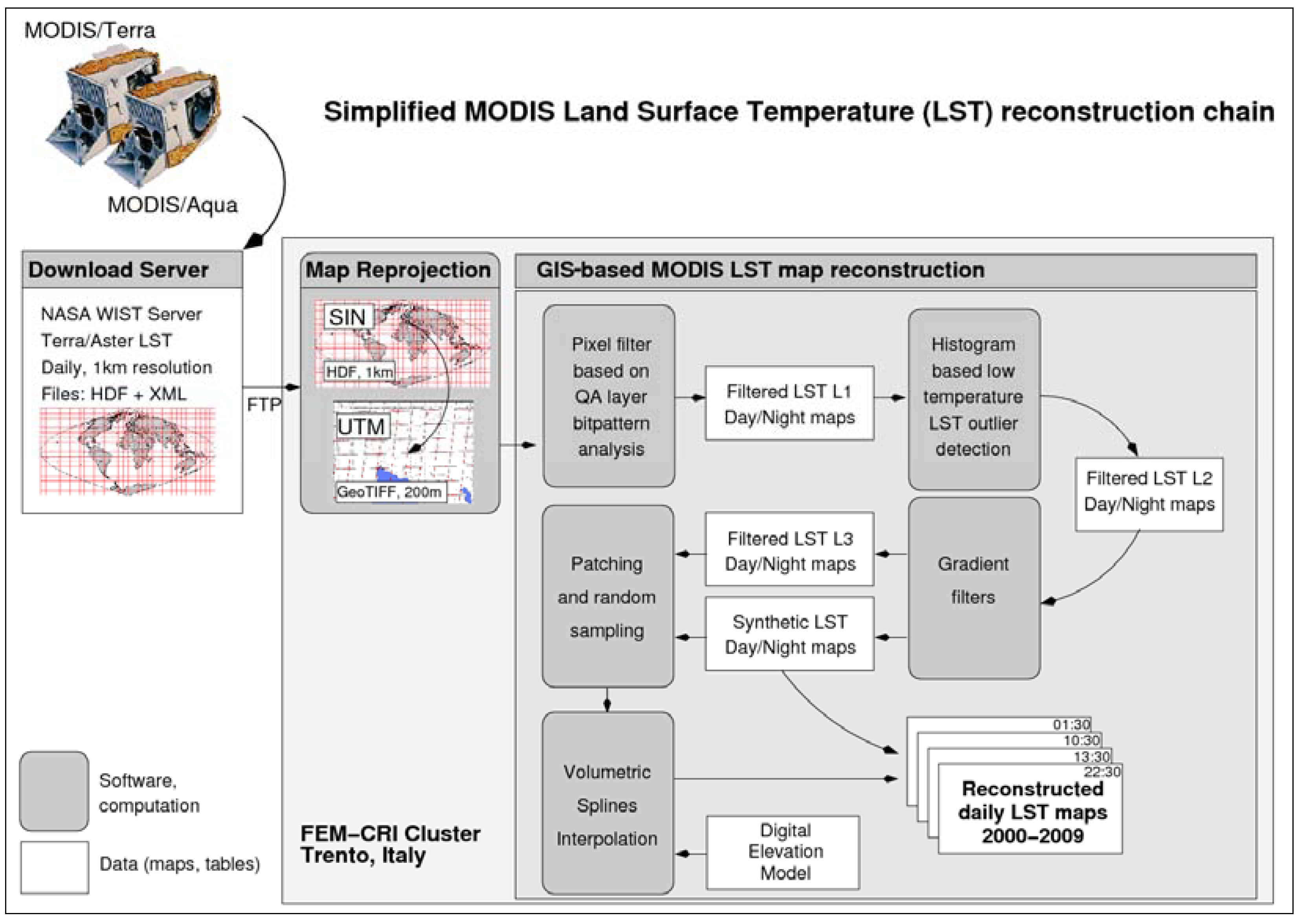
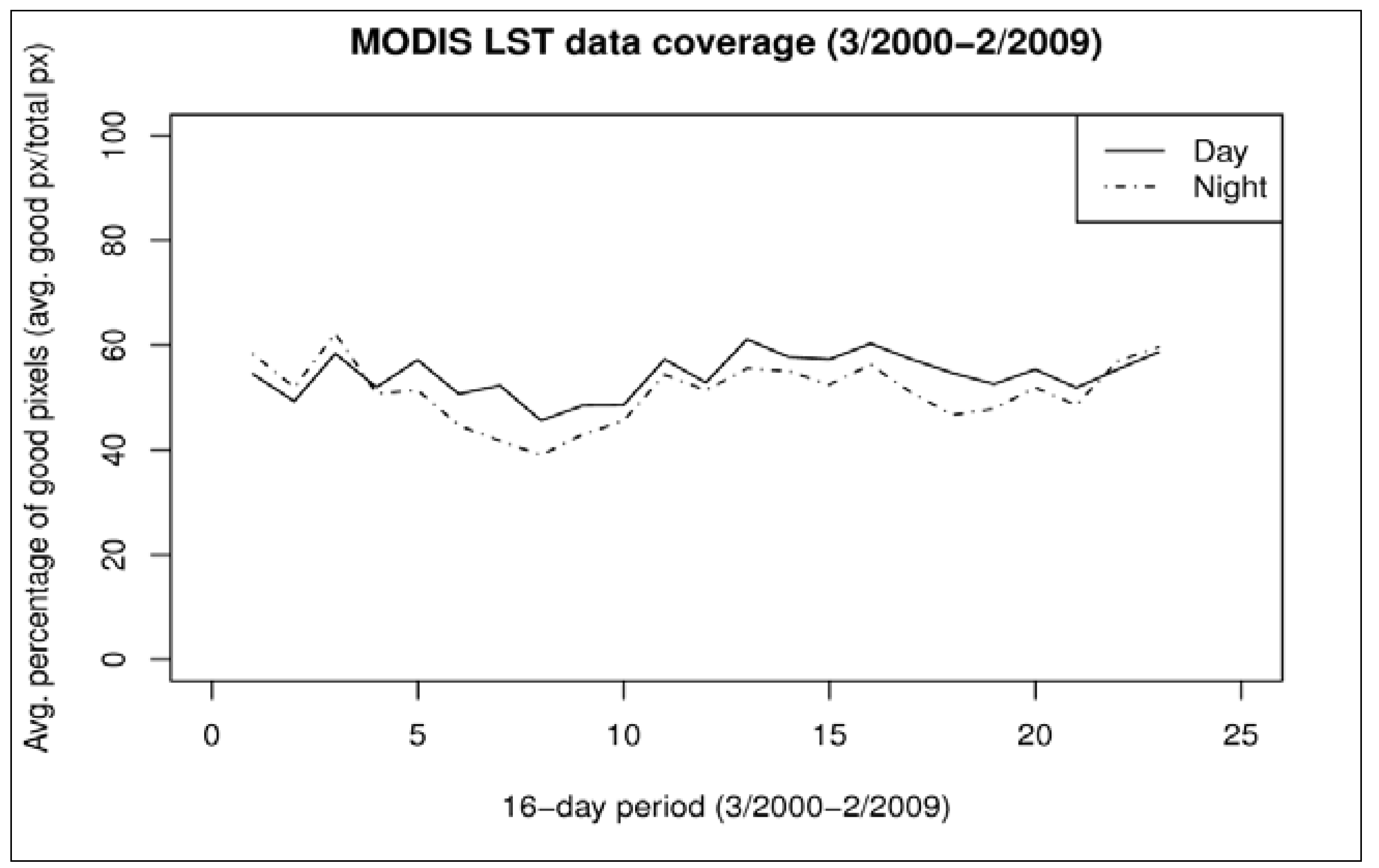


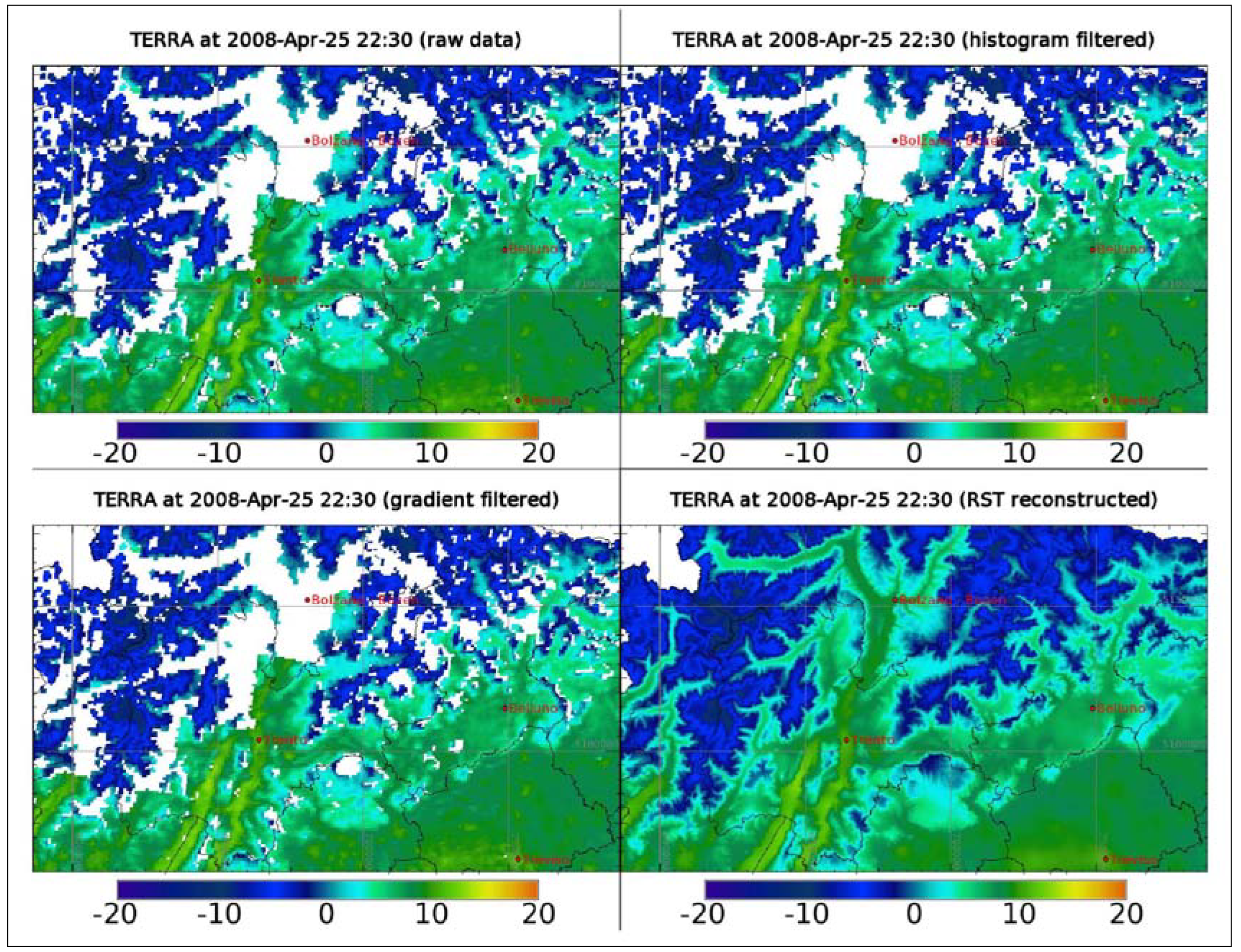

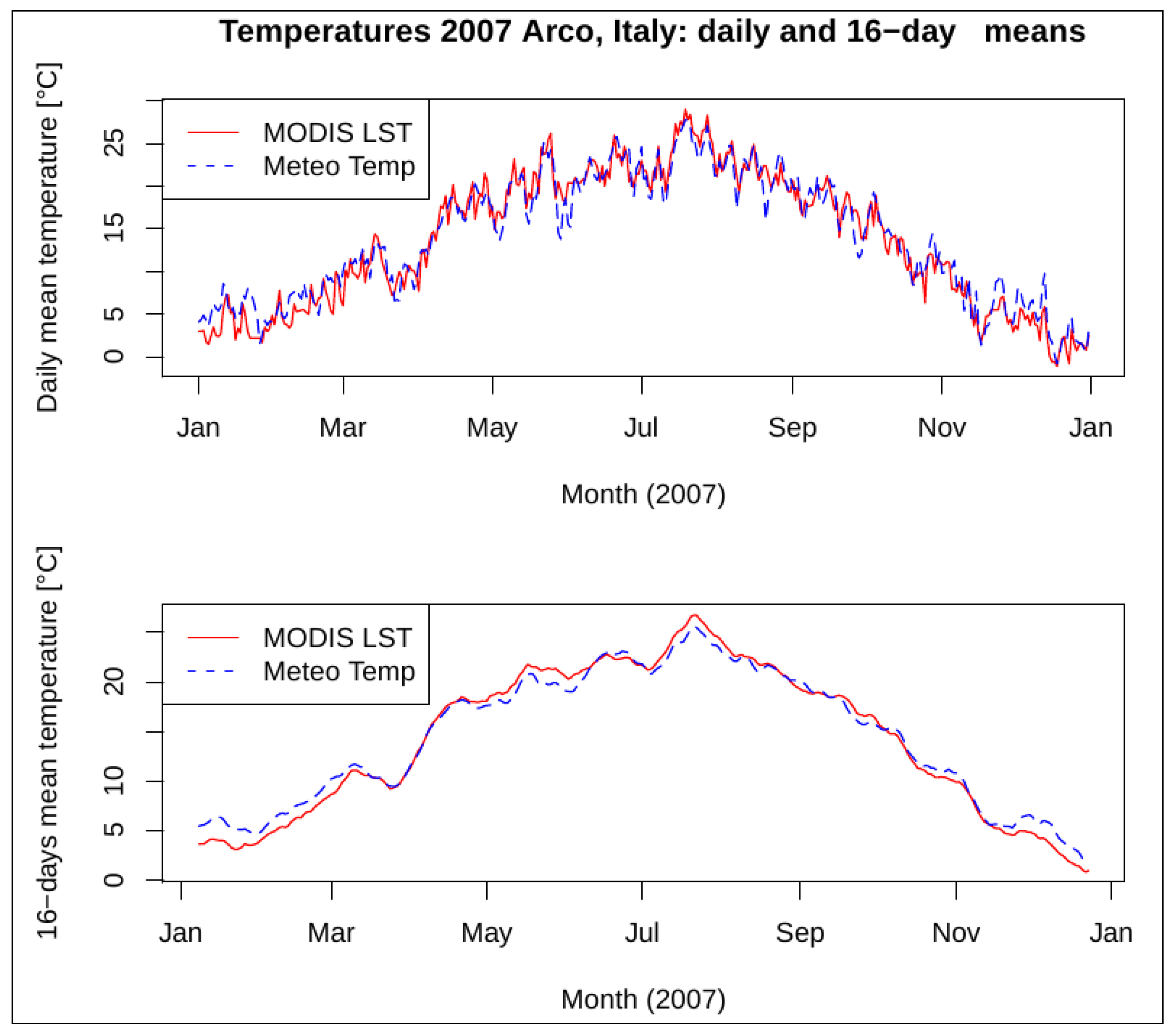
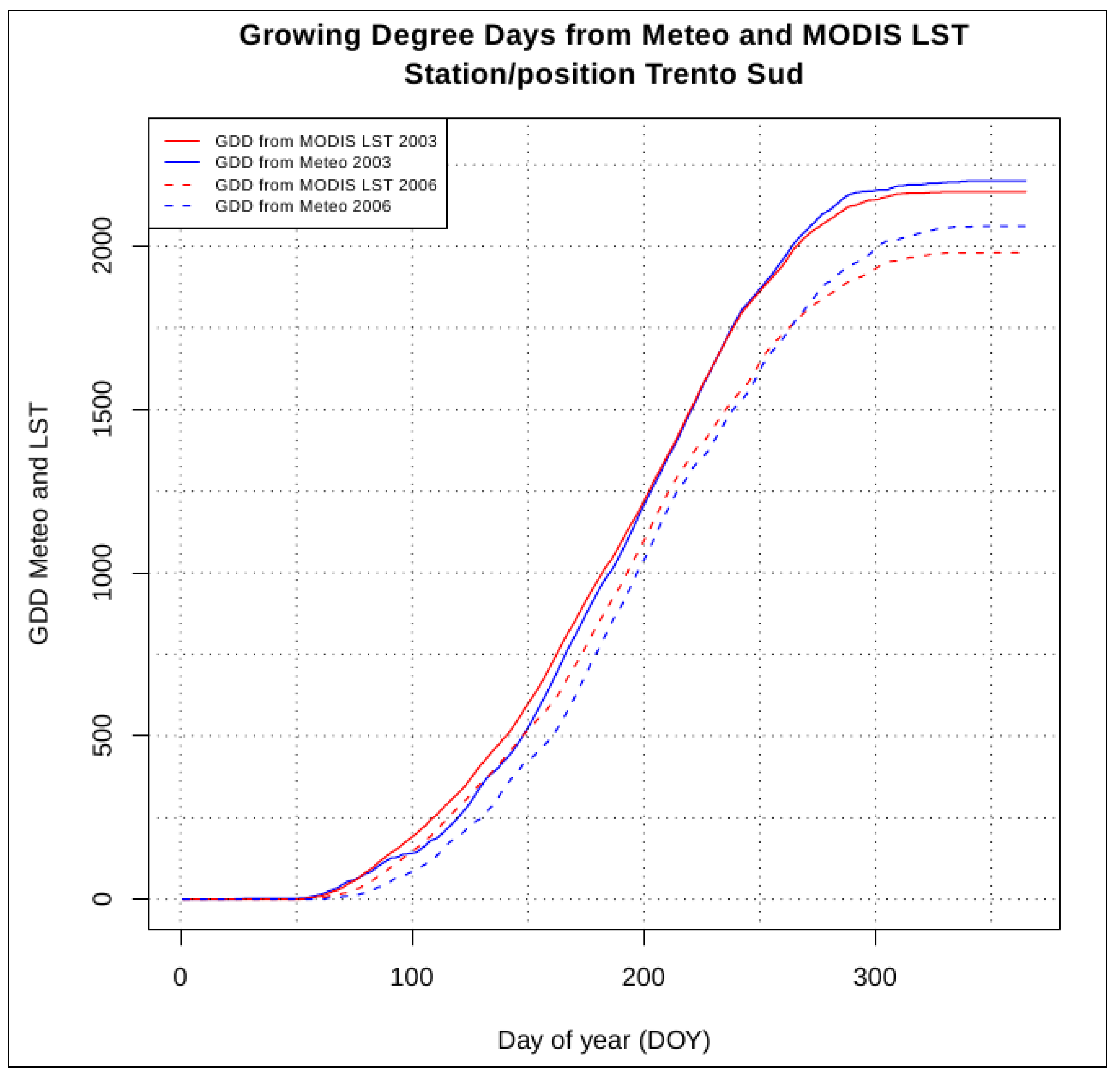
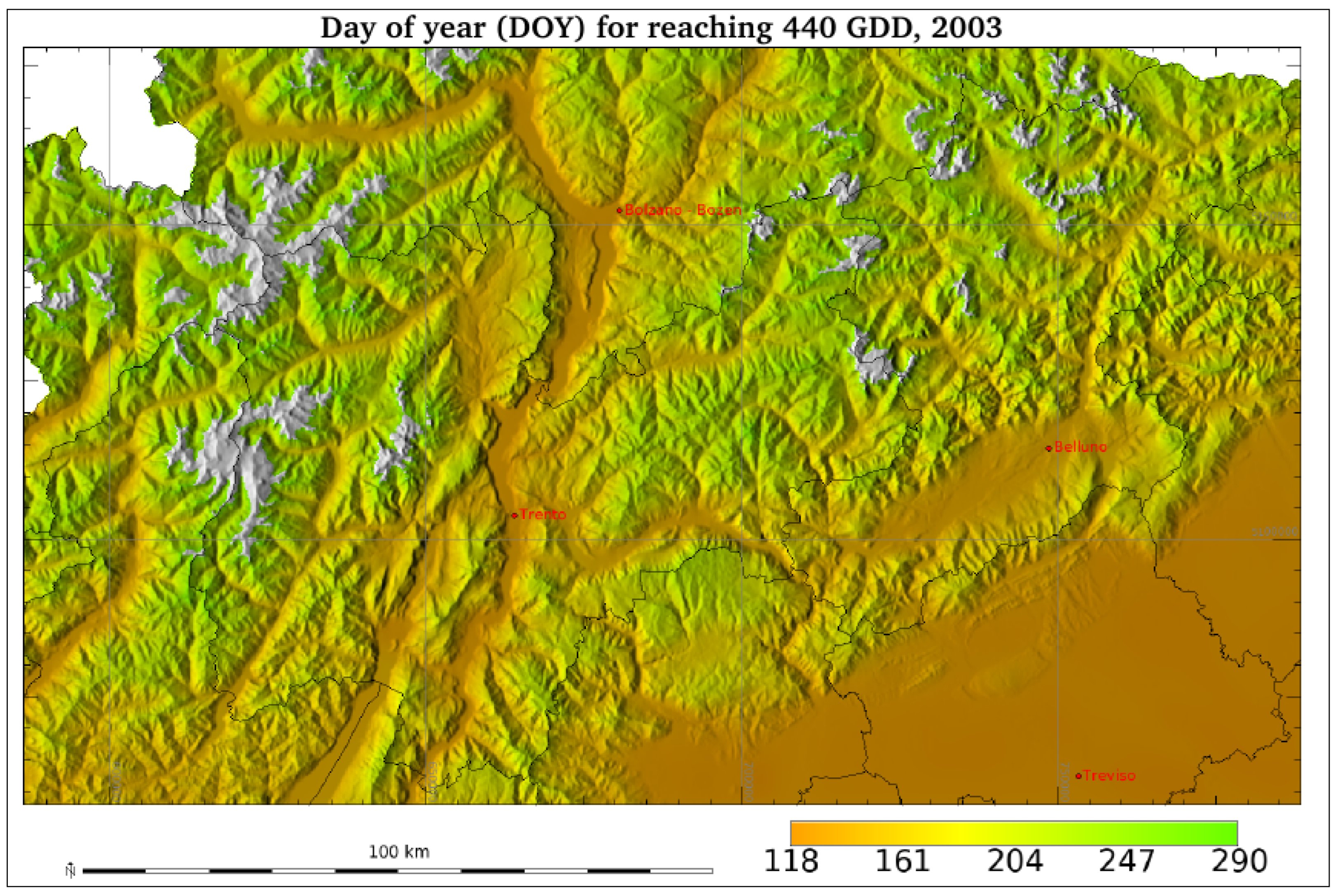
| Year | 0–499 m | 500–1,499 m | >1,500 m |
|---|---|---|---|
| 2000* | 30.0 | 36.0 | 36.1 |
| 2001* | 32.4 | 40.3 | 40.5 |
| 2002° | 27.0 | 33.6 | 35.9 |
| 2003 | 35.5 | 46.1 | 47.6 |
| 2004 | 31.5 | 39.2 | 41.6 |
| 2005 | 35.1 | 44.7 | 45.1 |
| 2006 | 34.7 | 43.8 | 46.1 |
| 2007 | 38.2 | 46.6 | 46.5 |
| 2008 | 28.3 | 33.4 | 34.0 |
| Mean | 32.5 | 40.4 | 41.5 |
| Stddev | 3.68 | 5.21 | 5.17 |
© 2010 by the authors. licensee Molecular Diversity Preservation International, Basel, Switzerland. This article is an open-access article distributed under the terms and conditions of the Creative Commons Attribution license (http://creativecommons.org/licenses/by/3.0/).
Share and Cite
Neteler, M. Estimating Daily Land Surface Temperatures in Mountainous Environments by Reconstructed MODIS LST Data. Remote Sens. 2010, 2, 333-351. https://doi.org/10.3390/rs1020333
Neteler M. Estimating Daily Land Surface Temperatures in Mountainous Environments by Reconstructed MODIS LST Data. Remote Sensing. 2010; 2(1):333-351. https://doi.org/10.3390/rs1020333
Chicago/Turabian StyleNeteler, Markus. 2010. "Estimating Daily Land Surface Temperatures in Mountainous Environments by Reconstructed MODIS LST Data" Remote Sensing 2, no. 1: 333-351. https://doi.org/10.3390/rs1020333
APA StyleNeteler, M. (2010). Estimating Daily Land Surface Temperatures in Mountainous Environments by Reconstructed MODIS LST Data. Remote Sensing, 2(1), 333-351. https://doi.org/10.3390/rs1020333



